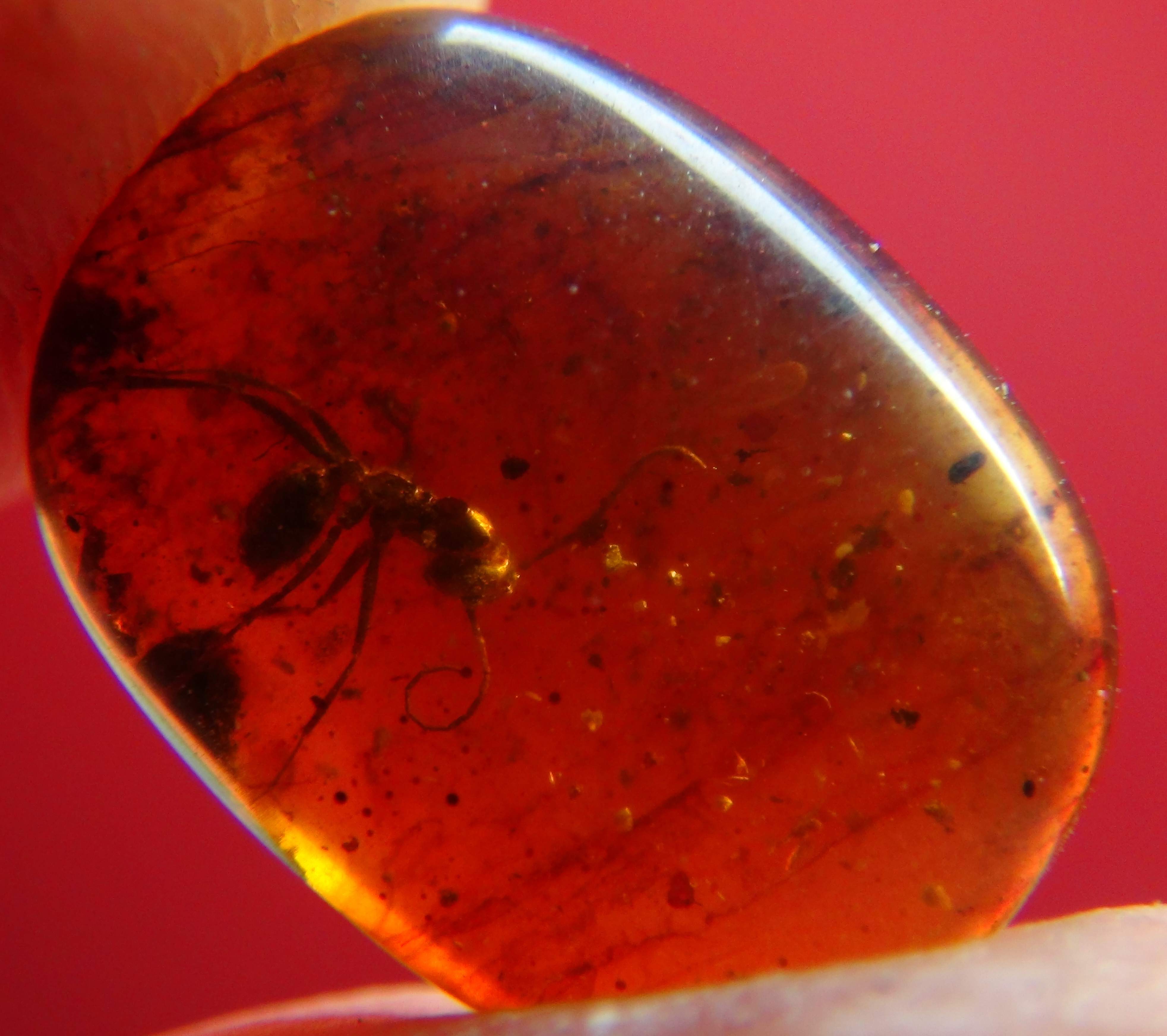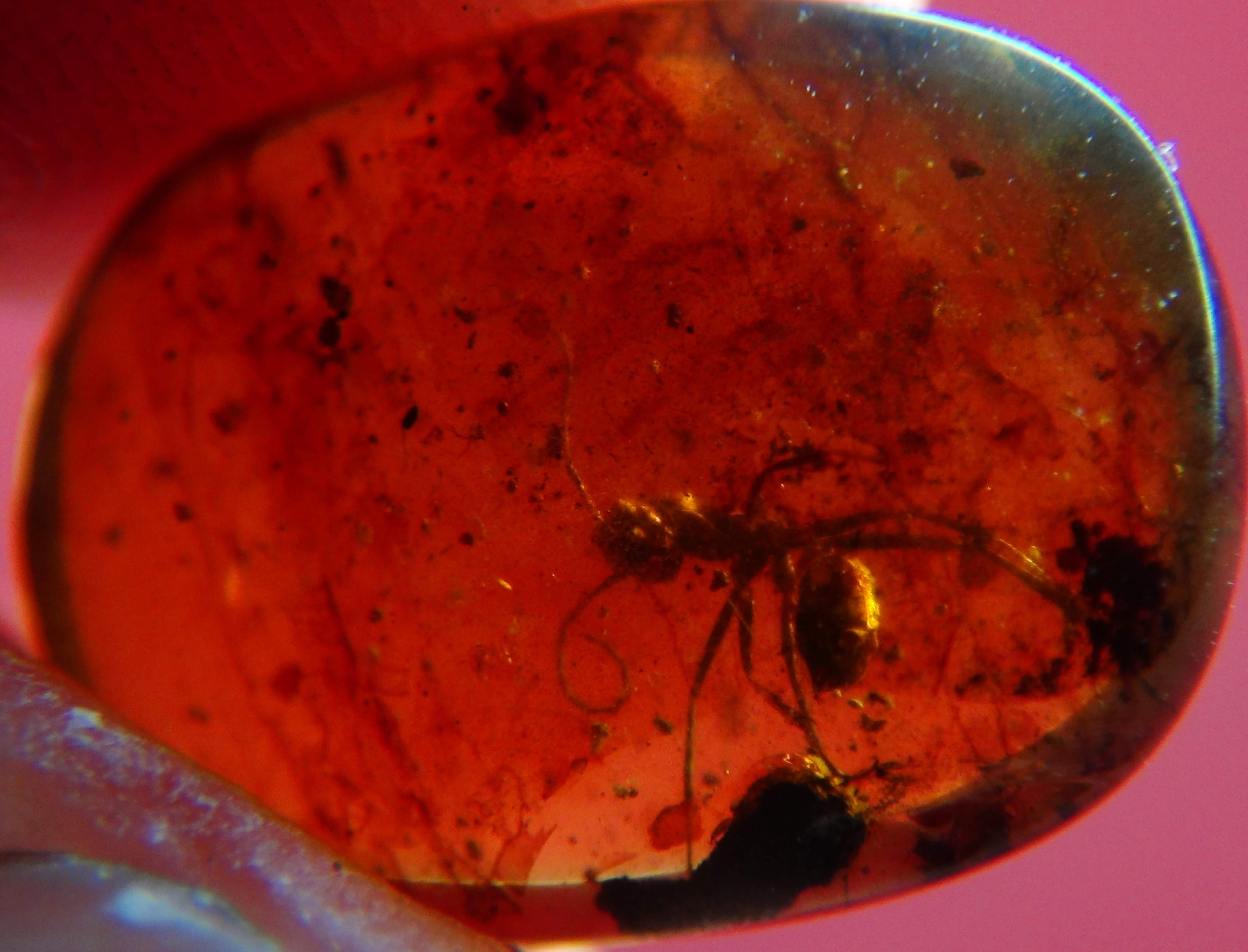Ants: They’re the model of cooperative hustle and super-efficient picnic pests. Unless you come into contact with the searing bite of a bullet ant or fire ant, you probably ignore the diminutive insects as a mere nuisance.
But perhaps you'd pay more attention if you ran into a particular kind of ant from the Cretaceous called a haidomyrmecine. Dubbed “hell ants” for their scimitar-like mandibles, five species have been identified over the last century in samples of Burmese, French and Canadian amber.
Now, analysis of these trapped ants and their spectacular headgear reveals them to be among the oldest true ants in the world. The insects lived between 78 and 99 million years ago and seem to be among the very earliest to diverge from the original ant-wasp family group.
“There are no ant fossils older than these, full stop,” says Phillip Barden, a postdoctoral fellow at Rutgers University. “But we estimate from molecular data and DNA analysis that they diversified 20 to 60 million years earlier.”
These ancient ants had long trigger hairs on their faces and dense mats of whiskers on their foreheads, which presumably acted like stopping-plates so an ant wouldn’t run itself through with its own swords. Based on these and other traits, Barden thinks the hell-ants’ jaws would have hinged upward, so that the ant skewered its still unknown prey—possibly soft-bodied insects—into the sky. Modern trap-jaw ants, whose mandibles snap shut laterally, use their jaws in much in the same way.
Even creepier, slight grooves on the inside of the hell-ants’ mandibles might have been used to funnel its prey’s bodily fluids down towards the mouth, Barden suggests, though this is just speculation for now.
In short, not only were these insects saber-toothed ants, they might have been vampire saber-toothed ants.
Despite their screaming weirdness, the ants somehow went virtually unnoticed for the better part of the 20th century. Entomologist Theodore Dru Alison Cockerell catalogued the first known haidomyrmecine specimen in 1920 but left it undescribed. The ant simply sat on a shelf at the Natural History Museum in London until 1996, when a Russian paleoentomologist, Gennady Dlussky, finally described the species and gave it its colorful name.
Ant in amber, we shall be posting many new pictures of ants in amber soon. Some ants have even been published by some zany journals as alien insects. Dr Grimaldi brought us racial conflict between warring ants. There are an unusually large number of ants in amber compared to other insects and some species are far more common than others.

Ant in amber

Top ants found in Burmite amber
cerberus (Hell Ant): This ant lived during the mid-Cretaceous period, around 99 million years ago. It is known for its unique, scythe-like mandibles, which suggest it was a predator capable of capturing and impaling soft-bodied prey.Gerontoformica rasilis: Also from the mid-Cretaceous period, this ant is distinctive for lacking a sting, which sets it apart from many modern ant species. This characteristic has offered insights into the evolutionary history of ant defense mechanisms.
Myanmyrma gracilis: This ant is relatively small and delicate, representing one of the earliest ant species found in Burmite. Its discovery has contributed to our understanding of early ant diversity.
Zhangsolvidris sp.: This ant is notable for its peculiar mouthparts and head shape. It is one of the more recently discovered ant species in Burmese amber, providing new information about the ancient ant fauna.
Prionomyrmex sp.: Belonging to the subfamily Prionomyrmecinae, this ant showcases some unique characteristics that distinguish it from other ant groups.
Anonychomyrma sp.: This ant is part of the diverse subfamily Myrmicinae, which includes many familiar ant species. Its presence in Burmese amber adds to our knowledge of ancient Myrmicinae diversity.
Sphecomyrmodes sp.: This ant belongs to the subfamily Formicidae, which encompasses a wide range of ant species. Its discovery has provided additional insights into the ancient ant fauna.
Ants discovered in Myanmar Amber - Formicidae
Baikuris sp.
Burmomyrma rossi Dlussky, 1996
Camelomecia janovitzi Barden & Grimaldi, 2016
Ceratomyrmex ellenbergeri Perrichot, Wang & Engel, 2016
Haidomyrmex cerberus Dlussky, 1996
Haidomyrmex scimitarus Barden & Grimaldi, 2012
Haidomyrmex zigrasi Barden & Grimaldi, 2012
Myanmyrma gracilis Engel & Grimaldi, 2005
Gerontoformica contegus (Barden & Grimaldi, 2014)
Gerontoformica gracilis (Barden & Grimaldi, 2014)
Gerontoformica magnus (Barden & Grimaldi, 2014)
Gerontoformica maraudera Barden & Grimaldi, 2016
Gerontoformica orientalis (Engel & Grimaldi, 2005)
Gerontoformica pilosus (Barden & Grimaldi, 2014)
Gerontoformica robustus (Barden & Grimaldi, 2014)
Gerontoformica rugosus (Barden & Grimaldi, 2014)
Gerontoformica spiralis (Barden & Grimaldi, 2014)
Gerontoformica subcuspis (Barden & Grimaldi, 2014)
Gerontoformica tendir (Barden & Grimaldi, 2014)
Zigrasimecia ferox Perrichot, (from an extinct genus of ant) 2014
Zigrasimecia tonsora Barden & Grimaldi, 2013
Anderson, S.R. 2009. A primitive ant brood chamber with evidence of brood care in Burmese amber (Lower Cretaceous) – implications for brood care as the facilitating factor for true eusociality and dominance of ants. Denisia, 26, 11-20.
Barden, P. & Grimaldi, D. 2013. A new genus of highly specialized ants in Cretaceous Burmese amber. Zootaxa, No. 3681 (4), 405-412.
Barden, P. & Grimaldi, D. 2016. Adaptive radiation in socially advanced stem-group ants from the Cretaceous. Current Biology, 26, 515-521.
Barden, P. & Grimaldi, D. 2014. A diverse ant fauna from the Mid-Cretaceous of Myanmar (Hymenoptera: Formicidae). PlosONE, 9(4), e93627, 1-20.
Barden, P. & Grimaldi, D. 2012. Rediscovery of the bizarre Cretaceous ant Haidomyrmex Dlussky (Hymenoptera: Formicidae), with two new species. American Museum Novitates, No. 3755, 16pp.
Perrichot, V. 2014. A new species of the Cretaceous ant Zigrasimecia based on the worker caste reveals placement of the genus in the Sphecomyrminae (Hymenoptera: Formicidae). Mymecological News, 19, 165-169.
Engel, M.S. & Grimaldi, D.A. 2005. Primitive new ants in Cretaceous amber from Myanmar, New Jersey, and Canada (Hymenoptera: Formicidae). American Museum Novitates, No. 3485, 23pp.
Ward, P.S. 2007. Phylogeny, classification, and species-level taxonomy of ants (Hymenoptera: Formicidae). Zootaxa, 1668, 549-563.
Dlussky, G.M. 1996. Ants (Hymenoptera: Formicidae) from Burmese amber. Paleontological Journal, 30(4): 449-454.



